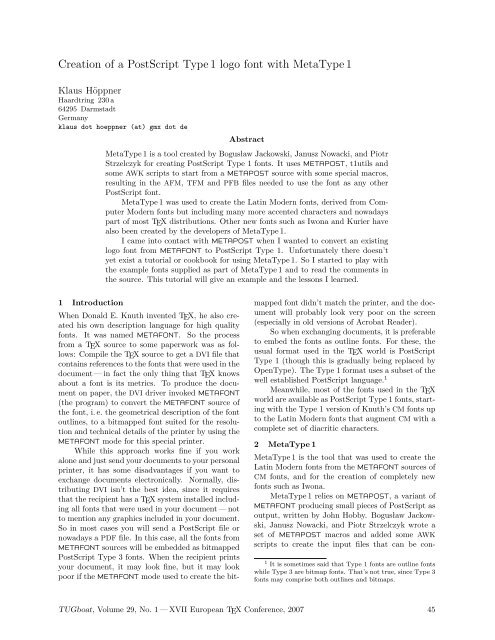Complete issue 29:1 as one pdf - TUG
Complete issue 29:1 as one pdf - TUG
Complete issue 29:1 as one pdf - TUG
Create successful ePaper yourself
Turn your PDF publications into a flip-book with our unique Google optimized e-Paper software.
Creation of a PostScript Type 1 logo font with MetaType 1<br />
Klaus Höppner<br />
Haardtring 230 a<br />
64<strong>29</strong>5 Darmstadt<br />
Germany<br />
klaus dot hoeppner (at) gmx dot de<br />
Abstract<br />
MetaType 1 is a tool created by Bogusław Jackowski, Janusz Nowacki, and Piotr<br />
Strzelczyk for creating PostScript Type 1 fonts. It uses METAPOST, t1utils and<br />
some AWK scripts to start from a METAPOST source with some special macros,<br />
resulting in the AFM, TFM and PFB files needed to use the font <strong>as</strong> any other<br />
PostScript font.<br />
MetaType 1 w<strong>as</strong> used to create the Latin Modern fonts, derived from Computer<br />
Modern fonts but including many more accented characters and nowadays<br />
part of most TEX distributions. Other new fonts such <strong>as</strong> Iwona and Kurier have<br />
also been created by the developers of MetaType 1.<br />
I came into contact with METAPOST when I wanted to convert an existing<br />
logo font from METAFONT to PostScript Type 1. Unfortunately there doesn’t<br />
yet exist a tutorial or cookbook for using MetaType 1. So I started to play with<br />
the example fonts supplied <strong>as</strong> part of MetaType 1 and to read the comments in<br />
the source. This tutorial will give an example and the lessons I learned.<br />
1 Introduction<br />
When Donald E. Knuth invented TEX, he also created<br />
his own description language for high quality<br />
fonts. It w<strong>as</strong> named METAFONT. So the process<br />
from a TEX source to some paperwork w<strong>as</strong> <strong>as</strong> follows:<br />
Compile the TEX source to get a DVI file that<br />
contains references to the fonts that were used in the<br />
document — in fact the only thing that TEX knows<br />
about a font is its metrics. To produce the document<br />
on paper, the DVI driver invoked METAFONT<br />
(the program) to convert the METAFONT source of<br />
the font, i. e. the geometrical description of the font<br />
outlines, to a bitmapped font suited for the resolution<br />
and technical details of the printer by using the<br />
METAFONT mode for this special printer.<br />
While this approach works fine if you work<br />
al<strong>one</strong> and just send your documents to your personal<br />
printer, it h<strong>as</strong> some disadvantages if you want to<br />
exchange documents electronically. Normally, distributing<br />
DVI isn’t the best idea, since it requires<br />
that the recipient h<strong>as</strong> a TEX system installed including<br />
all fonts that were used in your document — not<br />
to mention any graphics included in your document.<br />
So in most c<strong>as</strong>es you will send a PostScript file or<br />
nowadays a PDF file. In this c<strong>as</strong>e, all the fonts from<br />
METAFONT sources will be embedded <strong>as</strong> bitmapped<br />
PostScript Type 3 fonts. When the recipient prints<br />
your document, it may look fine, but it may look<br />
poor if the METAFONT mode used to create the bitmapped<br />
font didn’t match the printer, and the document<br />
will probably look very poor on the screen<br />
(especially in old versions of Acrobat Reader).<br />
So when exchanging documents, it is preferable<br />
to embed the fonts <strong>as</strong> outline fonts. For these, the<br />
usual format used in the TEX world is PostScript<br />
Type 1 (though this is gradually being replaced by<br />
OpenType). The Type 1 format uses a subset of the<br />
well established PostScript language. 1<br />
Meanwhile, most of the fonts used in the TEX<br />
world are available <strong>as</strong> PostScript Type 1 fonts, starting<br />
with the Type 1 version of Knuth’s CM fonts up<br />
to the Latin Modern fonts that augment CM with a<br />
complete set of diacritic characters.<br />
2 MetaType 1<br />
MetaType 1 is the tool that w<strong>as</strong> used to create the<br />
Latin Modern fonts from the METAFONT sources of<br />
CM fonts, and for the creation of completely new<br />
fonts such <strong>as</strong> Iwona.<br />
MetaType 1 relies on METAPOST, a variant of<br />
METAFONT producing small pieces of PostScript <strong>as</strong><br />
output, written by John Hobby. Bogusław Jackowski,<br />
Janusz Nowacki, and Piotr Strzelczyk wrote a<br />
set of METAPOST macros and added some AWK<br />
scripts to create the input files that can be con-<br />
1 It is sometimes said that Type 1 fonts are outline fonts<br />
while Type 3 are bitmap fonts. That’s not true, since Type 3<br />
fonts may comprise both outlines and bitmaps.<br />
<strong>TUG</strong>boat, Volume <strong>29</strong>, No. 1 — XVII European TEX Conference, 2007 45

















